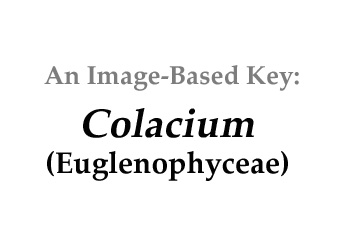|
Home / Euglenophyceae / Photosynthetic Euglenoids / Colacium |
||||
|
|
||||
|
|
||||
|
Click on images for larger format |
||||
Name derivation: |
||||
|
|
||||
Classification: |
||||
Colacium Ehrenberg 1834; 14 of 19 species descriptions are currently accepted taxonomically (Guiry 2013)Order Euglenophyceae incertae sedis; Family Colaciaceae |
||||
Morphology: |
||||
|
Colonial sessile euglenoid that forms bifurcate mucilaginous stalks. Cells are tear-drop shaped and attached to the stalk at its broad apical end. Numerous small discoid chloroplasts (Wolowski 2002). Short-lived (a few hours) flagellated cells with one emergent flagellum are occasionally produced that again become sessile and secrete a new mucilaginous stalk, initiating a new colony (Smith 1950). Four species have been found in the USA (Fosowski 2003). |
||||
Similar genera: |
||||
|
|
||||
Habitat: |
||||
|
Found in a shallow water lily pond across the road from Fort McClary, Kittery Point, Maine USA. Described as widespread in the USA and almost exclusively epizoic on aquatic invertebrates (Smith 1950). One species (C. libellee) has been found as a ‘mucilaginous palmelloid’ in the hindgut of damselfly nymphs and tadpoles (Rosowski and Willey 1975). Facultative heterotrophy (Rosowski 2003). |
||||
References: |
||||
Guiry, M.D. and Guiry, G.M. 2013. AlgaeBase. World-wide electronic publication, National University of Ireland, Galway. http://www.algaebase.org; searched on 15 January 2013. Leedale G. F. 1967. Euglenoid flagellates. Prentice-Hall. Rosowski, J.R. 2003. Photosynthetic Euglenoids. chapter 10 in Wehr, J.D. and R.G. Sheath. Freshwater Algae of North America. Academic Press. (918 pp.). Rosowsky, J.R., and R.L. Willey 1975. Colacium libellae sp. nov. (Euglenophyceae), a photosynthetic inhabitant of the larval damselfly rectum. J. Phycol. 11:310-315. Smith, G.M. 1950. The Fresh-Water Algae of the United States. McGraw-Hill. (719 pp.) Wolowski, K. 2002. Phylum Euglenophyta. In:The Freshwater Algal Flora of the British Isles. Cambridge. (702 pp.). |
||||




